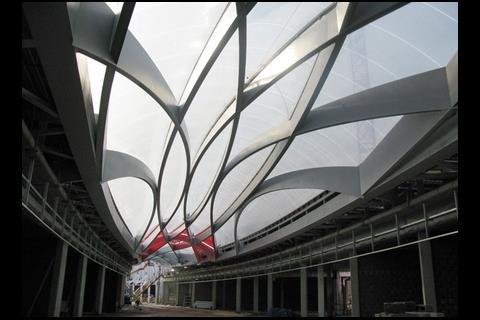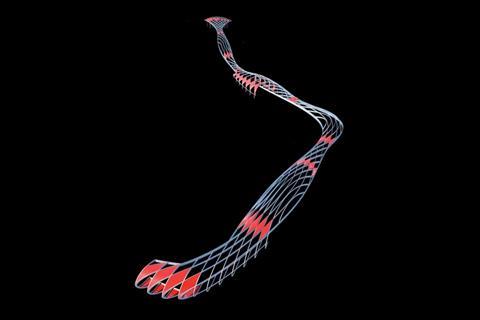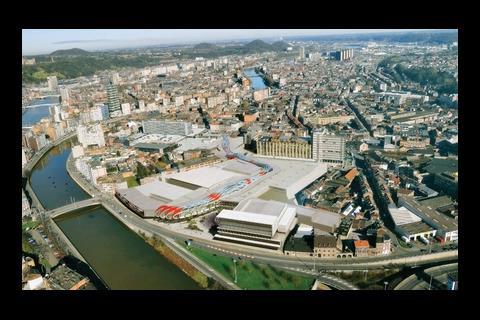Buro Happold’s roof for Liège’s new shopping centre takes the form of a 400m-long steel snake, which undulates to dramatically different heights. Stephen Kennett finds out how it was done
The €230m (£205m) Media City in Liège, the new home of national Belgian television station RTBF, contains everything you need for a good time, from state-of-the-art cinemas to an Olympic skating rink. The complex is based around some existing buildings, but the most striking element of it is a shopping centre in the form of a shiny 400m-long anaconda, which winds its way between the other buildings. In April 2007, when its foundations were being poured, the design for the roof consisted of nothing more than a few squiggles on a sketchpad; as the structure was practically all roof, this was a serious matter.
The drawings were put there by Ron Arad Associates, which had been brought into the project at the last minute to add some panache to the 40,000m2 scheme. This was partly because it was felt that this was appropriate for such a prestigious scheme, and partly because it had to compete with the soaring architecture of Santiago Calatrava’s railway station. Either way, it was an eccentric choice on the part of Wilhelm & Co, the scheme’s developer. Ron Arad is probably best know for its furniture; certainly, it had never tackled a project of this scale before. What’s more, it had a mere nine months to come up with a design, get it out to tender and begin fabrication.
In such a situation, simplicity might seem the safest approach, but instead the architect decided on a complex, heavily engineered structure that dips to almost head height in places and rises to 20m at the entrance. Steel ribs of varying depths span the length, rather than the breadth, of the building and cross over each other in a distorted gridshell. Two years later, the Belgian contractor, Iemants, is installing the final section of the roof, and the scale and complexity of the design can be appreciated. But exactly how did the project team and its suppliers manage such a feat?
Geoff Crowther, the project architect, says the original idea was to create an undulating roof to bring the site together. The plan for the scheme had already been set and the path followed by the mall was to expand to 28m in some places, and shrink to 7m in others. It also had to step up in height from one to two storeys. “We had this idea of a long river of steel that grows and shrinks in height to create spaces that are quite intimate and also cathedral-like,” he says.
The challenge was translating this vision into something that could be built in time and to budget. Soon after the architects had decided on the form the surface of the roof would take, Buro Happold was brought on board to handle the structural design.
We had this idea of a long river of steel that grows and shrinks in height to create spaces that are quite intimate and also cathedral-like
Geoff Crowther, Ron Arad Associates
“The first thing we did,” says John Noel, the project’s structural engineer, “was to make sure the initial concept would be affordable and not overly complex.” The design team decided to cut the number of longitudinal ribs from 14 down to a maximum of 10 to make the structure lighter and reduce the number of connections; the roof’s curvature was tweaked to make it more efficient.
The engineer then began thinking about the roof covering. ETFE cushions – translucent and red tinted – rather than glass were chosen for their lightness and also because they could adapt to the complex geometry of the design without additional framing.
At the same time the roof was split into eight independent sections stretching up to 60m. “Because the roof is so long, any small variation in temperature would have a huge impact, so you must break the structure up with movement joints,” says Noel.
The plan was to make the roof structure from 685 box sections that would be welded together to create the lattice. To analyse the design, Buro Happold first built its own model (see below). This showed that there were places where the structure was over-engineered. This was mainly the result of variations in the depth of the ribs, which in theoriginal design went from 1,600mm to 400mm as the roof dipped and rose. “It turned out that in some places where you didn’t need the depth the beams were very deep and where you did need it they were shallow,” says Noel. Subtle changes were introduced to the dimensions of the beams to help balance the structural needs.
The analysis also showed money could be saved by optimising the thickness of the steel used for the ribs. The architect set the width of the ribs at 200mm, but the thickness of the sidewalls could be varied from 8mm up to 25mm. Similarly the thickness of the steel used for the top and bottom flanges could be varied depending on the position of the rib in the structure. “We could play with the thickness of the steel so it didn’t compromise the architecture,” says Noel.
Because the roof is so long, any small variation in temperature would have a huge impact
John Noel, Buro Happold
The engineer also had to consider fire performance. Belgium’s fire standards for shopping centres require each roof section to be able to withstand a 675ÞC fire for half an hour. The aim was to avoid having to coat the steel in intumescent paint, which they managed to demonstrate was possible on seven of the eight roof sections – an exercise that saved about €300,000 (£269,000).
When Iemants was appointed in January 2008 the design underwent a second value-engineering exercise. As it was, the roof used a mix of straight ribs, sections that curve only in plan or elevation and some that curve in both. They are all made in the same way – the sidewalls are placed in a jig so that the top and bottom webs can be welded in place. The cost of making up a double-curved section is more than twice that of a straight rib. “Once we knew that, we revisited the design to find areas where they could be replaced with straight pieces,” says Noel. The exercise helped shave a further 8% off the steel costs.
In March 2008, fabrication of the ribs, which vary between 4m and 15m in length, began. For the first roof section, Iemants assembled the entire structure in its yard, spot welding the ribs in position to check the geometry. “They wanted to make sure when they took everything to site it would all fit,” says Noel. After the third section, the fabricator was confident enough to send the remaining five roof sections straight to site.
Later this month the final section of the roof will be complete. Crowther says there were probably a million times when he didn’t think it was going to be possible, but that now it is completed, he is impressed by its sheer scale. Media City is due to open this November and there’s little doubt it will establish Liège’s architectural credentials.
How was it modelled?
When Ron Arad Associates began designing the roof that snakes over Media City, the architects created a parametric model of its flowing surface using Autodesk’s Maya. This set the perimeter of the roof plan and allowed the designers to try out different curvatures and experiment with surface depths. Onto this surface they then projected the grid of steel ribs, which in turn gave their position, size and curvature. However, it wasn’t possible to use this model to assess if the design would be structurally sound, says Jal El-Ali, senior designer with Buro Happold.
To get around this the engineers first took the 3D model built by the architects and opened it in a drawing package called Rhino where each beam was given a unique name. A specially programmed script devised by El-Ali was then run that would generate a data file with all the information on the beams including their depth and the exact position of the centre lines.
However, analysing the beams was made more complex because as well, as their depth varying, they curve and twist. To get around this, each beam was sliced up into discrete 0.5m-long linear segments. The resulting data was then fed into Autodesk Robot for the structural analysis.
The same datafile was also used for the fabrication. This time the beams were sliced into smaller segments – down to 10mm where the curvature is tightest – to minimise the faceting and fed into a programme called Bocad where it could be used to programme the machines for cutting the steel.
Postscript
Original print headline: 'Tubular belge'.
Specifier 22 May 2009
- 1
- 2
- 3
- 4
- 5
- 6
- 7
- 8
- 9
- 10
 Currently reading
Currently readingTubular belge: Buro Happold's steel shopping centre


































No comments yet